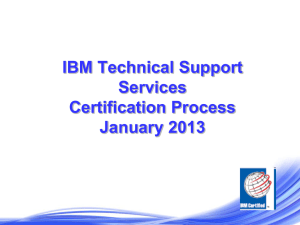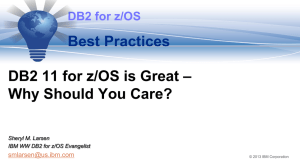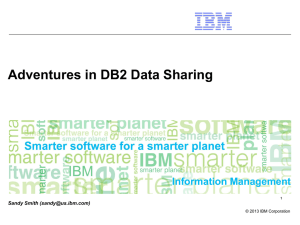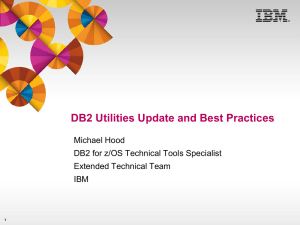Title Slide - DFW DB2 Forum
advertisement
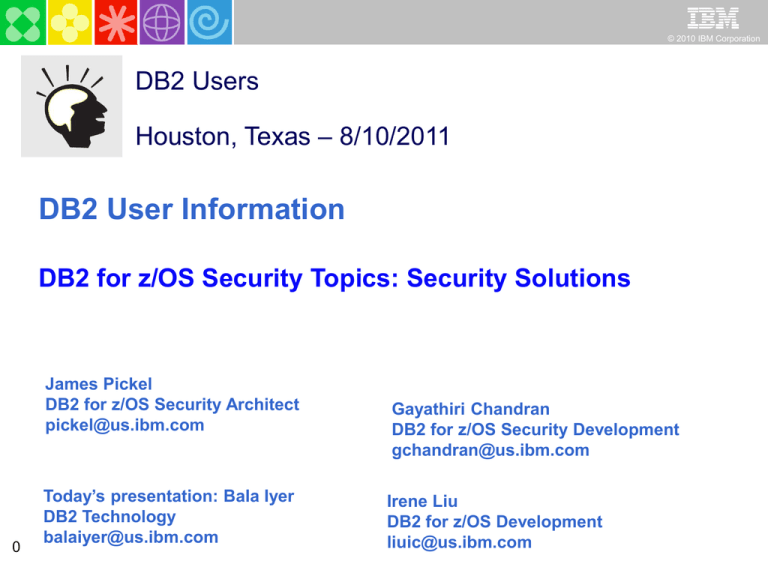
© 2010 IBM Corporation
DB2 Users
Houston, Texas – 8/10/2011
DB2 User Information
DB2 for z/OS Security Topics: Security Solutions
James Pickel
DB2 for z/OS Security Architect
pickel@us.ibm.com
0
Today’s presentation: Bala Iyer
DB2 Technology
balaiyer@us.ibm.com
Gayathiri Chandran
DB2 for z/OS Security Development
gchandran@us.ibm.com
Irene Liu
DB2 for z/OS Development
liuic@us.ibm.com
© 2010 IBM Corporation
Coming soon
Security Functions with DB2 10 for z/OS
SG24-7959-00
Redbooks
Ibm.com/redbooks
Current Status
– Draft under review
Topics Covered
– DB2 Capabilities
– Implementing Data Access Control
– Remote Client Application Access
– Database Monitoring and Audit Applications
– DB2 Temporal Support
– Security tools for discovery and control
– Auditing and IBM Infosphere Guardium
– Use Case
– Cryptography
1
© 2010 IBM Corporation
Facing the Mandate of Regulatory Compliance
2
Health Insurance Portability and Accountability Act of 1996
Graham-Leachy-Bliley Act of 1999
Sarbanes-Oxley Act
California Senate Bill 1386
Payment Card Industry Data Security Standard
Basel I
Basel II
© 2010 IBM Corporation
Information is an organizations critical asset
Cost of Information Breach
– Forensic Analysis and Internal Investigation
– Notification campaign: email, phone call, letters, ..
– Increased call center costs due to volume of customer traffic
– Legal cost of defense and investigation
– Internal investigation resulting in mitigation
– Triage to salvage customer and investor relations
– Fees and Penalties
3
© 2010 IBM Corporation
Full Financial Cost fall out of Secondary Damage
4
Loss of Employee Productivity
Erosion of customer confidence
Reticence of new customers to establish relationships
Reduced shareholder confidence and value
Decreased competitive standing
© 2010 IBM Corporation
V10 Theme: Satisfy Your Auditor: Plan, Protect and Audit
Data Access
– Minimize the use of a superuser
authorities such as SYSADM
– A different group should manage
access to restricted data than the
owner of the data
Database
Administrator
Tasks
Security
Administrator
Tasks
Data Auditing
– Any dynamic access or use of a
privileged authority needs to be
included in your audit trail
– Maintain historical versions of data for
years or during a business period
Data Privacy
– All dynamic access to tables containing
restricted data needs to be protected
5
SQL based
Auditing
Temporal
Data
Row & Column
Access Controls
Today’s Mainframe:
The power of industry-leading security,
the simplicity of centralised management
© 2010 IBM Corporation
Reduce risk by minimizing use of SYSADM
New granular system authorities
New in DB2 10
Prior to DB2 10
SYSADM
System DBADM
DBADM
ACCESSCTRL
DBCTRL
6
DBMAINT
DATAACCESS
SYSCTRL
SECADM
PACKADM
SQLADM
SYSOPR
EXPLAIN
Prior to V10 DBADM Continues to exist
© 2010 IBM Corporation
Reduce risk by minimizing use of SYSADM
New install security parameters
Prevents SYSADM and SYSCTRL from granting or revoking
privileges: SEPARATE_SECURITY
• New separate security install zparm parameter
• New install SECADM authority manages subsystem security
• SYSADM and SYSCTRL can no longer implicitly grant or revoke
privileges
Control cascading effect of revokes: REVOKE_DEP_PRIVILEGES
• New revoke dependent privileges install parameter
• New revoke dependent privileges SQL clause
7
© 2010 IBM Corporation
New authority for performing security tasks
without ability to change or access data
SECADM authority
• Allows the user to
– Issue SQL GRANT, REVOKE statements on all grantable
privileges and administrative authorities
– Manage DB2 9 roles and trusted contexts
– Manage DB2 10 row permissions and column masks
– Manage DB2 10 Audit policies
– Access catalog tables
– Issue START, STOP, and DISPLAY TRACE commands
8
© 2010 IBM Corporation
New authority for managing objects without
ability to access data or control access to data
System DBADM authority
• Allows the user to
– Issue SQL CREATE, ALTER, DROP statements to manage
most objects in the DB2 subsystem
– Exception: Security objects, system objects
– Additional privileges required to create objects such as
views, functions, triggers
– Issue most DB2 commands
– Execute system defined stored procedures and functions
– Access catalog tables
9
© 2010 IBM Corporation
New authority for accessing data without the
ability to manage data or control access to data
DATAACCESS authority
• Allows the user to
– Issue SQL SELECT, INSERT, UPDATE, DELETE statements
on all user tables, views, materialized query tables
– Execute all plans, packages and routines
– Run RECOVERDB, REORG, REPAIR, LOAD utilities on all
user databases
– Issue ALTER and TERM UTILITY commands
– Access catalog tables
10
© 2010 IBM Corporation
New authority for controlling access to data
without ability to manage or access data
ACCESSCTRL authority
• Allows the user to
– Issue SQL GRANT, REVOKE statements on most grantable
privileges and administrative authorities
– Exceptions:
– System DBADM, DATAACCESS, ACCESSCTRL
authorities
– Security privilege, CREATE_SECURE_OBJECT
– Access catalog tables
11
© 2010 IBM Corporation
New authority for monitoring and tuning SQL
without ability to change or access data
SQLADM authority
• Allows the user to
– Issue SQL EXPLAIN statements
– Issue START, STOP, and DISPLAY PROFILE commands
– Execute system defined stored procedures and functions
– Access catalog tables
• Perform actions involving:
– EXPLAIN privilege
– STATS privilege on all user databases
– MONITOR2 privilege
• Cannot access data, perform DDL or execute
12
© 2010 IBM Corporation
New privilege to validate SQL before moving
application into production without risk to data
EXPLAIN privilege
– Allows the user to
Issue SQL EXPLAIN ALL statement without having the privileges
to execute that SQL statement
Issue SQL PREPARE and DESCRIBE TABLE statements without
requiring any privileges on the object.
Specify new BIND EXPLAIN(ONLY) and SQLERROR(CHECK)
options
Explain dynamic SQL statements executing under new special
register, CURRENT EXPLAIN MODE = EXPLAIN
13
© 2010 IBM Corporation
RACF support for the new Administrative
Authorities
RACF Access Control Module (‘SYS1.SDSNSAMP
(DSNXRXAC)’) has been enhanced to
– Honor the setting of SEPARATE_SECURITY
– Implement the new DB2 administrative authorities as
RACF resource checks
14
DB2 Authority
Resource
Class
SECADM
<subsystem>.SECADM
DSNADM
System DBADM
<subsystem>.SYSDBADM
DSNADM
DATAACCESS
<subsystem>.DATAACCESS
DSNADM
ACCESSCTRL
<subsystem>.ACCESSCTRL
DSNADM
SQLADM
<subsystem>.SQLADM
MDSNSM
EXPLAIN
<subsystem>.EXPLAIN
MDSNSM
© 2010 IBM Corporation
Satisfy Your Auditor:
New audit policies provide needed flexibility and
functionality
■
15
New auditing capability allows you to comply without
the need of external data collectors
● New audit policies managed in catalog
●
Audit privileged users
●
Audit SQL activity against a table
●
Audit distributed identities
© 2010 IBM Corporation
New Audit Policies Feature
• Your security administrator using the new SECADM
authority maintains DB2 audit policies in a new catalog table
• SYSIBM.SYSAUDITPOLICIES
• Audit policies enabled using –STA TRACE command
• Audit policies disabled using –STO TRACE command
• Up to 8 audit policies can be specified to auto start or auto
start as secure during DB2 start up
• Only user with SECADM authority can stop a secure audit
policy trace
16
© 2010 IBM Corporation
New Audit Policies Feature
•
Auditor audit access to specific tables for specific programs
during day
– Audit policy does not require AUDIT clause to be specified using DDL to
enable auditing
– Audit policy generate records for all read and update access not just first
access
– Audit policy includes additional records identifying the specific SQL
statements
•
– Audit policy provides wildcarding of based on schema and table names
Auditor can identify any unusual use of a privileged authority
–Records each use of a system authority
–Audit records written only when authority is used for access
–External collectors only report users with a system authority
17
© 2010 IBM Corporation
New improved security features provide more effective
controls and accurate audit trail for remote access
Support distributed identities introduced in z/OS V1R11
– A distributed identity is a mapping between a RACF user ID and one
or more distributed user identities, as they are known to application
servers
Support client certificates and password phrases in z/OS V1R10
– AT-TLS secure handshake accomplishes identification and
authentication when the client presents its certificate as identification
and its proof-of-possession as authentication
– A RACF password phrase is a character string made up of mixedcase letters, numbers, special characters, and is between 9 to 100
characters long
18
Support connection level security enforcement
– Enforces connections must use strong authentication to access DB2
– All userids and passwords encrypted using AES, or connections
accepted on a port which ensures AT-TLS policy protection or
protected by an IPSec encrypted tunnel
© 2010 IBM Corporation
Satisfy Your Auditor:
New table controls to protect against unplanned
SQL access
■ Define additional data controls at the row and column level
– Security policies are defined using SQL
– Separate security logic from application logic
■ Security policies based on real time session attributes
– Protects against SQL injection attacks
– Determines how column values are returned
– Determines which rows are returned
■ No need to remember various view or application names
– No need to manage many views; no view update or audit issues
■ All access via SQL including privileged users, adhoc query tools,
report generation tools is protected
■ Policies can be added, modified, or removed to meet current company
rules without change to applications
19
© 2010 IBM Corporation
Table controls to protect SQL access to individual
row level
Establish a row policy for a table
– Filter rows out of answer set
– Policy can use session information, e.g. the SQL ID is in what group or
user is using what role, to control which row is returned in result set
– Applicable to SELECT, INSERT, UPDATE, DELETE, & MERGE
– Defined as a row permission:
CREATE PERMISSION policy-name ON table-name
FOR ROWS WHERE search-condition
ENFORCED FOR ALL ACCESS ENABLE;
» Optimizer inserts search condition in all SQL statements accessing
table. If row satisfies search-condition, row is returned in answer set
20
© 2010 IBM Corporation
Table controls to protect SQL access to individual
column level
Establish a column policy for a table
– Mask column values in answer set
– Policy can use session information, e.g. the SQL ID is in what
group or user is using what role, to control what masked value is
returned in result set
– Applicable to the output of outermost subselect
– Defined as column masks :
CREATE MASK mask-name ON table-name
FOR COLUMN column-name RETURN CASE-expression
ENABLE;
21
Optimizer inserts CASE expression in all SQL statements accessing
table to determine mask value to return in answer set
© 2010 IBM Corporation
Define table policies based on who is
accessing a table
SESSION_USER - Primary authorization ID of the process
CURRENT SQLID - SQL authorization ID of the process
– SET CURRENT SQLID = string-constant;
VERIFY_GROUP_FOR_USER function
– Get authorization IDs for the value in SESSION_USER
– Includes both primary and secondary authorization IDs
– Return 1 if any of those authorization IDs is in the argument list
WHERE
VERIFY_GROUP_FOR_USER (SESSION_USER, ‘MGR’, ‘PAYROLL’) = 1
VERIFY_ROLE_FOR_USER function
– Get the role for the value in SESSION_USER
– Return 1 if the role is in the argument list
WHERE
VERIFY_ROLE_FOR_USER (SESSION_USER, ’MGR’, ‘PAYROLL’) = 1
22
© 2010 IBM Corporation
Managing row and column access controls
When activated row and column access controls:
– All row permissions and column masks become effective in all DML
– All row permissions are connected with ‘OR’ to filter out rows
– All column masks are applied to mask output
– All access to the table is prevented if no user-defined row permissions
ALTER TABLE table-name
ACTIVATE ROW
ACCESS CONTROL
ACTIVATE COLUMN ACCESS CONTROL;
When deactivated row and column access controls:
– Make row permissions and column masks become ineffective in DML
– Opens all access to the table
ALTER TABLE table-name
DEACTIVATE ROW
ACCESS CONTROL
DEACTIVATE COLUMN ACCESS CONTROL;
23
© 2010 IBM Corporation
Example – A simple banking scenario
Only allow customer service representatives to see customer data but
always with masked income
Table: CUSTOMER
24
Account
Name
Phone
Income
Branch
1111-2222-3333-4444
Alice
111-1111
22,000
A
2222-3333-4444-5555
Bob
222-2222
71,000
B
3333-4444-5555-6666
Louis
333-3333
123,000
B
4444-5555-6666-7777
David
444-4444
172,000
C
© 2010 IBM Corporation
Define row and column access control
on customer table
●
Define row and column policies for customer service representatives
– Allow
–
access to all customers of the bank (a row permission)
Mask all INCOME values (a column mask)
– Return value 0 for incomes of 25000 and below
–
25
–
Return value 1 for incomes between 25000 and 75000
–
Return value 2 for incomes between 75000 and 150000
–
Return value 3 for incomes above 150000
Customer service representatives are in the CSR group (who)
© 2010 IBM Corporation
Create a row permission for customer service representatives
CREATE PERMISSION CSR_ROW_ACCESS ON CUSTOMER
FOR ROWS WHERE
VERIFY_GROUP_FOR_USER (SESSION_USER, ’CSR’) = 1
ENFORCED FOR ALL ACCESS ENABLE;
Create a column mask on INCOME column for customer service
representatives
CREATE MASK INCOME_COLUMN_MASK ON CUSTOMER
FOR COLUMN INCOME RETURN
CASE WHEN (VERIFY_GROUP_FOR_USER (SESSION_USER, ‘CSR’) = 1)
THEN CASE WHEN (INCOME > 150000) THEN 3
WHEN (INCOME > 75000) THEN 2
WHEN (INCOME > 25000) THEN 1
ELSE 0
END
ELSE NULL
END
ENABLE;
26
© 2010 IBM Corporation
Start enforcing row and column access
control on customer table
Activate Row and Column Access Control
ALTER TABLE CUSTOMER
ACTIVATE ROW
ACCESS CONTROL
ACTIVATE COLUMN ACCESS CONTROL;
COMMIT;
What happens in DB2?
– A default row permission is created implicitly to prevent all access to
table CUSTOMER (WHERE 1=0) except for users in the CSR group
– All packages and cached statements that reference table CUSTOMER
are invalidated
27
Selecting from customer table
© 2010 IBM Corporation
… after row and column access control
activated
SELECT ACCOUNT, NAME, INCOME, PHONE FROM CUSTOMER;
ACCOUNT
NAME
INCOME
PHONE
1111-2222-3333-4444
Alice
0
111-1111
2222-3333-4444-5555
Bob
1
222-2222
3333-4444-5555-6666
Louis
2
333-3333
4444-5555-6666-7777
David
3
444-4444
INCOME automatically masked by DB2!
28
© 2010 IBM Corporation
DB2 effectively evaluates the following
revised query:
SELECT ACCOUNT,
NAME,
CASE WHEN (VERIFY_GROUP_FOR_USER (SESSION_USER, ‘CSR’) = 1)
THEN CASE WHEN (INCOME > 150000) THEN 3
WHEN (INCOME > 75000) THEN 2
WHEN (INCOME > 25000) THEN 1
ELSE 0
END
ELSE NULL
END INCOME,
PHONE
FROM CUSTOMER
WHERE VERIFY_GROUP_FOR_USER (SESSION_USER, ‘CSR’) = 1 OR 1 = 0 ;
29
© 2010 IBM Corporation
More rules about row and column
access
General
– Managed by SECADM authority
– ALTER PERMISSION | MASK
– ENABLE, DISABLE, or REGENERATE
– DROP PERMISSION | MASK
– Not enforced for RI, CHECK or UNIQUE CONSTRAINT
– Preserve data integrity
– Require secure triggers
– CREATE or ALTER TRIGGER with the SECURED option
– Managed by SECADM or new privilege CREATE_SECURE_OBJECT
– Rebind trigger packages implicitly after ALTER TRIGGER
– Not enforced for transition variables and transition tables
30
© 2010 IBM Corporation
More rules about row and column
access
General
– Require secure UDFs
– Referenced in the row permission and column mask definition
– CREATE or ALTER FUNCTION with the SECURED option
– Managed by SECADM or new privilege CREATE_SECURE_OBJECT
– Require privileges of DROPing a table to TRUNCATE a TABLE
– Populate access control information in EXPLAIN tables
– Can activate Access Control on EXPLAIN tables
– Limited support for GROUP BY
– No support for MQT
– No support for set operations
31
© 2010 IBM Corporation
More rules about row and column
access
Row permission specifics
– INSERT, UPDATE, MERGE handled like symmetric views
CREATE PERMISSION INCOME_ROW_ACCESS ON CUSTOMER
FOR ROWS WHERE
VERIFY_GROUP_FOR_USER (SESSION_USER, ’MGR’) = 1 AND
INCOME < 100000
ENFORCED FOR ALL ACCESS;
COMMIT;
ALTER TABLE CUSTOMER ACTIVATE ROW ACCESS CONTROL;
COMMIT;
Linda with secondary authorization ID ‘MGR’ issues an UPDATE:
UPDATE CUSTOMER SET INCOME = 150000
WHERE ACCOUNT = ‘1111-2222-3333-4444’
SQLCODE -20471
32
– Consider row permission predicates in access path selection
More rules about row and column
access
Column mask specifics
© 2010 IBM Corporation
– Do not interfere operations such as WHERE, GROUP BY, HAVING, ORDER BY,
SELECT DISTINCT …
– Do not affect how to determine a read-only cursor or view
– Applied to input columns before function evaluation
– Applied to columns in the source of INSERT, UPDATE, MERGE
– Column mask must map the column to itself or a run time error
CREATE MASK ACCOUNT_COLUMN_MASK ON CUSTOMER
FOR COLUMN ACCOUNT RETURN
CASE WHEN (VERIFY_GROUP_FOR_USER (SESSION_USER,’MGR’ ) = 1)
THEN ACCOUNT
ELSE CHAR('xxxx-xxxx-xxxx-‘) || SUBSTR(ACCOUNT,16,4)
END
ENABLE;
ALTER TABLE CUSTOMER ACTIVATE COLUMN ACCESS CONTROL;
COMMIT;
Peter with secondary authorization ID ‘CSR’ issues an INSERT:
33
INSERT INTO CUST_TEMP SELECT ACCOUNT FROM CUSTOMER; SQLCODE -20471
© 2010 IBM Corporation
Satisfy Your Auditor:
DB2 can now manage different versions of your
data
Application programmers and database administrators have struggled
for years with managing different versions of application data.
New regulatory laws require maintaining historical versions of data for
years.
Every update and delete of data requires applications to copy data to
history tables.
Existing approaches to application level data versioning complicate
table design, add complexity and are error prone for applications.
DB2 10 can automatically maintain different versions of your
data
34
SYSTEM_TIME temporal table supports data “versioning” where DB2
automatically archives old rows into a history table
© 2010 IBM Corporation
Add system versioning to a table to help audit
all changes to your data
After the base and history tables are appropriately defined:
– ALTER TABLE table-name ADD VERSIONING is specified
on the base table that is to be versioned, not the history
table
Auditor can query historical data through SQL
– New FOR SYSTEM_TIME clauses:
table-name FOR SYSTEM_TIME AS OF timestamp-expression
table-name FOR SYSTEM_TIME FROM timestamp-expression1 TO
timestamp-expression2
table-name FOR SYSTEM_TIME BETWEEN timestamp-expression1
AND timestamp-expression2
DB2 rewrites the user’s query to include data from the
history table with a UNION ALL operator
35
© 2010 IBM Corporation
DB2 10 for z/OS Security Enhancements
Help Satisfy Your Auditors using new features
36
New granular authorities to reduce data exposure for administrators
New auditing features using new audit policies comply with new laws
New row and column access table controls to safe guard your data
New temporal data to comply with regulations to maintain historical
data
© 2010 IBM Corporation
Questions?
37
© 2010 IBM Corporation
www.ibm.com/developerworks/data/bestpractices/db2zos/
Watch recorded presentations and read articles from your favorite DB2 experts.
Get practical recommendations for areas such as:
– Virtual storage tuning
– Security
– Software maintenance strategies
– Migration
– Setting up application servers to
access DB2 for z/OS
– Partitioning table spaces
– Debugging stored procedures
And more!
Send feedback and topic suggestions to db2zinfo@us.ibm.com
38
© 2010 IBM Corporation
Red book
For More Information (example)
example
Resources Now Available
New Redbook
– Governance Presentations on Software
DB2
10 for z/OS
Sellers Workplace
Technical
– GovernanceOverview
Overview
– Security & Privacy
SG24-7892-00
– Lifecycle
– Quality
– Solution Briefs
– “Information Governance:
Orchestrate people, process and
technology for success”
– “Six Easy Steps for Smart
Governance”
– IBM Security Solutions
39
© 2010 IBM Corporation
40
© 2010 IBM Corporation
Disclaimer/Trademarks
Information concerning non-IBM products was obtained from the suppliers of those products, their published announcements, or other publicly available sources. IBM has not tested
those products and cannot confirm the accuracy of performance, compatibility, or any other claims related to non-IBM products. Questions on the capabilities of non-IBM products
should be addressed to the suppliers of those products .
The information on the new products is intended to outline our
general product direction and it should not be relied on in making a
purchasing decision. The information on the new products is for
informational purposes only and may not be incorporated into any
contract. The information on the new products is not a commitment,
promise, or legal obligation to deliver any material, code or
functionality. The development, release, and timing of any features
or functionality described for our products remains at our sole
discretion.
This information may contain examples of data and reports used in daily business operations. To illustrate them as completely as possible, the examples include the names of
individuals, companies, brands, and products. All of these names are fictitious, and any similarity to the names and addresses used by an actual business enterprise is entirely
coincidental.
41
Trademarks The following terms are trademarks or registered trademarks of other companies and have been used in at least one of the pages of the presentation:
The following terms are trademarks of International Business Machines Corporation in the United States, other countries, or both: DB2 Universal Database, eServer, FlashCopy, IBM,
IMS, iSeries, Tivoli, z/OS, zSeries, Guardium, IBM Smart Analytics Optimizer, Data Encryption Tool for IMS and DB2 Databases, DB2 Administration Tool / DB2 Object Compare for
z/OS, DB2 Audit Management Expert for z/OS, DB2 Automation Tool for z/OS, DB2 Bind Manager for z/OS, DB2 Change Accumulation Tool for z/OS, DB2 Cloning Tool for z/OS, DB2
High Performance Unload for z/OS, DB2 Log Analysis Tool for z/OS, DB2 Object Restore for z/OS, DB2 Path Checker for z/OS, DB2 Query Management Facility for z/OS, DB2 Query
Monitor for z/OS, DB2 Recovery Expert for z/OS, DB2 SQL Performance Analyzer for z/OS, DB2 Table Editor for z/OS , DB2 Utilities Enhancement Tool for z/OS, DB2 Utilities Suite for
z/OS, InfoSphere Change Data Capture, InfoSphere Data Event Publisher, InfoSphere Replication Server, Optim Data Growth Solution for z/OS, Optim Development Studio, Optim
pureQuery Runtime, Optim Query Workload Tuner, Optim Test Data Management Solution for z/OS, Tivoli OMEGAMON XE for DB2 Performance Expert on z/OS
EMC and TimeFinder are trademarks of EMC Corporation
Hitachi is a traademark of Hitchi Ltd
Microsoft, Windows, Windows NT, and the Windows logo are trademarks of Microsoft Corporation in the United States, other countries, or both.
Java and all Java-based trademarks are trademarks of Sun Microsystems, Inc. in the United States, other countries, or both.
Other company, product, or service names may be trademarks or service marks of others.



